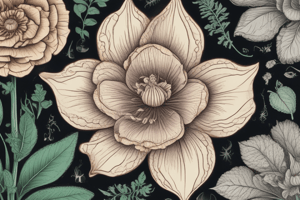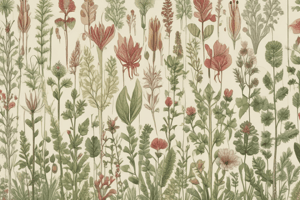Podcast
Questions and Answers
What is the primary function of trichomes in the shoot system?
What is the primary function of trichomes in the shoot system?
- Enhance aesthetic appearance of plants
- Facilitate nutrient absorption
- Increase photosynthesis efficiency
- Prevent water loss due to transpiration (correct)
Which tissue type is NOT a part of the ground tissue system?
Which tissue type is NOT a part of the ground tissue system?
- Parenchyma
- Vascular bundles (correct)
- Collenchyma
- Sclerenchyma
What distinguishes subsidiary cells from normal epidermal cells?
What distinguishes subsidiary cells from normal epidermal cells?
- Location on stems only
- Ability to photosynthesize
- Presence of chloroplasts
- Specialisation in shape and size (correct)
In which part of the plant are parenchymatous cells typically located?
In which part of the plant are parenchymatous cells typically located?
How do the shapes of guard cells contribute to their function?
How do the shapes of guard cells contribute to their function?
What is the main function of the cuticle in the epidermal tissue system?
What is the main function of the cuticle in the epidermal tissue system?
Which of the following statements about guard cells is correct?
Which of the following statements about guard cells is correct?
How are the epidermal cells typically arranged in the epidermis?
How are the epidermal cells typically arranged in the epidermis?
What is the role of stomata in plants?
What is the role of stomata in plants?
Which type of plant tissues is NOT mentioned as one of the three tissue systems?
Which type of plant tissues is NOT mentioned as one of the three tissue systems?
Which feature of guard cells differs in grasses compared to other plants?
Which feature of guard cells differs in grasses compared to other plants?
What type of cells make up the epidermis?
What type of cells make up the epidermis?
In what area of the plant is the cuticle generally absent?
In what area of the plant is the cuticle generally absent?
Flashcards
Plant Anatomy
Plant Anatomy
The study of the internal structure of plants.
Tissue Systems in Plants
Tissue Systems in Plants
Different types of tissues organized in a plant, including epidermal, ground, and vascular.
Epidermal Tissue System
Epidermal Tissue System
The outermost layer of a plant, protecting it.
Epidermis
Epidermis
Signup and view all the flashcards
Stomata
Stomata
Signup and view all the flashcards
Guard Cells
Guard Cells
Signup and view all the flashcards
Cuticle
Cuticle
Signup and view all the flashcards
Parenchyma Cells
Parenchyma Cells
Signup and view all the flashcards
Subsidiary cells
Subsidiary cells
Signup and view all the flashcards
Stomatal apparatus
Stomatal apparatus
Signup and view all the flashcards
Root hairs
Root hairs
Signup and view all the flashcards
Trichomes
Trichomes
Signup and view all the flashcards
What is ground tissue?
What is ground tissue?
Signup and view all the flashcards
Study Notes
Plant Internal Structure and Tissue Systems
- Plant anatomy studies the internal structure of plants
- Plants are made of cells, tissues, and organs
- Different plant organs have different internal structures
- Monocots and dicots have anatomical differences
- Internal structures adapt to different environments
Tissue Systems
- Three types of tissue systems in plants: -Epidermal tissue system -Ground tissue system -Vascular tissue system -Tissue structure and function vary based on location
Epidermal Tissue System
- Forms the outermost covering of the plant
- Includes epidermal cells, stomata, and trichomes (hairs)
- Epidermis is a single layer of compactly arranged cells -Cells are parenchymatous with a large vacuole
- Cuticle (waxy layer) prevents water loss (except in roots)
- Stomata regulate transpiration and gas exchange -Guard cells control stomatal opening/closing -Subsidiary cells surround stomata -Stomatal apparatus includes guard cells and subsidiary cells
- Trichomes (hairs) on stems and roots -Root hairs absorb water and minerals -Shoot trichomes prevent water loss, may be secretory.
Ground Tissue System
- All plant tissues except epidermis and vascular bundles
- Composed of simple tissues (parenchyma, collenchyma, sclerenchyma)
- Parenchyma cells are in cortex, pericycle, pith, and medullary rays.
- Leaf mesophyll is the ground tissue in leaves (chloroplast-containing cells)
Studying That Suits You
Use AI to generate personalized quizzes and flashcards to suit your learning preferences.




